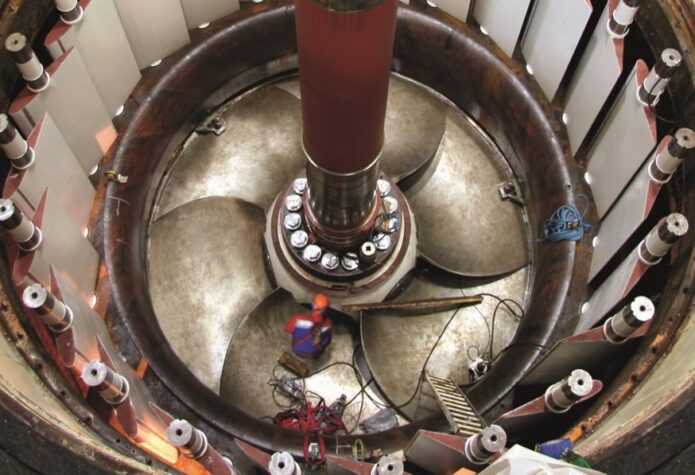Where the water flows

Hydropower generated from the rivers of Lapland is crucial in Finland’s strategy to expand its production of renewable energy.
The sun is shining in a perfectly blue sky over the serene river and lake landscape of Finnish Lapland. It is a late September day, and the surrounding countryside is showing its finest autumn colours to the visiting NIB crew. We are standing on the bank of the longest river in Finland, the Kemijoki, admiring the beautiful mountains reflected in the calm waters.
But the peace and quiet exists only on the surface. Underground, directly below us, a giant water turbine is running at full capacity. We are about to visit Finland’s largest tunnel hydropower plant, Pirttikoski, run by the Finnish hydropower company Kemijoki.
Massive construction
Inside the plant, 60 metres down by elevator, the sound of heavy construc- tion work almost drowns out the voice of our guide, Kemijoki Director Kari Jokinen. He tells us that the fifty-yearold turbines in the plant are swallowing their last gallons of water this year. They are now being replaced by modern, state-of-the-art equipment. One of the two turbines in the plant is already being replaced, and the other one still in use will be replaced next summer.
The installation of the new turbines is part of a renovation programme that Kemijoki started already in 1996. All of the company’s hydropower plants are being renovated and the machinery replaced. Pirttikoski and its neighbouring plant Vanttauskoski are the last two under construction.
“The life cycle of a hydropower plant is about 40 to 50 years and when this renovation project is completed, we will have started a new cycle for our plants,” says Mr Jokinen.
The new generators will increase the plant’s output of renewable and emission-free energy by 20-40%. The increase in output will be enough to recoup the investment.
More green energy needed
In 2008, the Finnish government submitted its new national energy and climate strategy to parliament. The strategy is Finland’s answer to the European climate action and renewable energy package, in which the EU has committed itself to reduce greenhouse gas emissions by 20% by 2020.
The country-specific target for Finland is for renewable energy production to cover 38% of the end use of energy within the same time limit. This will put pressure on green energy producers such as Kemijoki. In 2008, renewable energy accounted for about 27% of the total end use.
“Finland’s role in the strategy is extremely challenging,” says Aimo Takala, CEO of Kemijoki.
“Finland will need to turn over every stone there is to reach this goal, and Kemijoki is contributing by adding more hydropower capacity. But hydropower alone will not be sufficient to meet the new requirements for renewable energy production. Finland will also have to develop substantial production capacity in wind power and biofuels.”
Kemijoki is Finland’s largest producer of hydroelectric power. The company owns twenty hydropower plants connected to three river systems in Finland. Sixteen power plants and eight dams are operated along the river Kemijoki, which has given its name to the company.
The aim of the Kemijoki company is not to maximise its profits, but to supply hydropower to its owners at cost price. The Finnish state is the major stakeholder with half of the company’s total share capital, while private owners account for the other half.
Green effects
The variable and unstable nature of wind power makes hydropower a requisite complement as a power source. Wind and other weather conditions cannot be regulated; when the wind is not blowing, there is no output from the wind power plants.
“Hydropower production, on the other hand, is superior in balancing power output, since water can be stored in dams and used when needed. The output from the turbines can be changed within seconds, compared to other power plants that need hours to increase or decrease the produced power,” explains Mr Takala.
The replacement of the turbines in the Kemijoki plants will result in a considerable increase in the output of such flexible, green energy in Finland. But Mr Takala points out that there are several positive environmental effects of the project:
“The new turbines will not need any hydraulic fluids for lubrication, only air and water. This will eliminate the risk of oil leakage into the environment.”
A perfect match
NIB has participated in the financing of the renovation programme with a loan of EUR 25 million to Kemijoki. Sebastian Påwals, Senior Manager at NIB, says that the environmental effects of the project are important for the Bank:
“Clearly, there are substantial reductions of greenhouse gas emissions to be gained from investments like this, since any increase in renewable energy production crowds out fossil fuel production.”
But he also points out that the Kemijoki loan in fact fares well vis à vis both of the Bank’s operational mandates-to enhance the environment and competitiveness.
“The operational idea of Kemijoki, to supply its owners with hydropower at cost price, increases the competitiveness of the owner companies. And the new technology in the plants will make production even more cost-efficient. So mandate-wise, this is a very strong project for NIB, and we are happy to participate.”
Mr Takala agrees that the cooperation has been rewarding. He points out that NIB’s involvement provided the project with added value:
“For us as a company it is important to have international financial institutions like NIB as partners. It gives credibility to the project. And it is also of great value to us that NIB assesses the projects, for example from an environmental point of view. It gives us a certain merit-apart from the direct financial side of the cooperation,” he comments.
And according to Mr Påwals, more NIB-financed investments in green energy production can be expected in the future.
“The European climate action sets new standards for emission-free energy production, and NIB is pleased to assist in financing relevant investments. Projects like this are really almost tailor-made for us,” he concludes.
